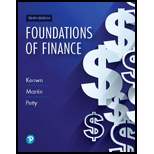
Foundations Of Finance
10th Edition
ISBN: 9780134897264
Author: KEOWN, Arthur J., Martin, John D., PETTY, J. William
Publisher: Pearson,
expand_more
expand_more
format_list_bulleted
Concept explainers
Textbook Question
Chapter 11, Problem 19SP
(Risk-adjusted NPV) The Hokie Corporation is considering two mutually exclusive projects. Both require an initial outlay of $10,000 and will operate for 5 years. Project A will produce expected cash flows of $5,000 per year for years 1 through 5, whereas project B will produce expected cash flows of $6,000 per year for years 1 through 5. Because project B is the riskier of the two projects, the management of Hokie Corporation has decided to apply a required
Expert Solution & Answer
Want to see the full answer?
Check out a sample textbook solution
Students have asked these similar questions
How do companies evaluate the feasibility of a project using NPV and IRR?
What are derivatives, and how are they used in hedging?
What are index funds, and why are they popular among long-term investors in finance?
Chapter 11 Solutions
Foundations Of Finance
Ch. 11.A - Prob. 1MCCh. 11.A - Prob. 2MCCh. 11 - Prob. 1RQCh. 11 - Prob. 2RQCh. 11 - If a project requires an additional investment in...Ch. 11 - Prob. 4RQCh. 11 - Prob. 5RQCh. 11 - Prob. 6RQCh. 11 - Prob. 1SPCh. 11 - (Relevant cash flows) Captins Cereal is...
Ch. 11 - Prob. 3SPCh. 11 - Prob. 4SPCh. 11 - Prob. 5SPCh. 11 - Prob. 6SPCh. 11 - Prob. 7SPCh. 11 - Prob. 9SPCh. 11 - Prob. 10SPCh. 11 - Prob. 11SPCh. 11 - Prob. 12SPCh. 11 - Prob. 15SPCh. 11 - (Real options and capital budgeting) You have come...Ch. 11 - (Real options and capital budgeting) Go-Power...Ch. 11 - (Real options and capital budgeting) McDoogals...Ch. 11 - (Risk-adjusted NPV) The Hokie Corporation is...Ch. 11 - (Risk-adjusted discount rates and risk classes)...Ch. 11 - Prob. 1MCCh. 11 - Prob. 2MCCh. 11 - Prob. 3MCCh. 11 - Prob. 7MCCh. 11 - Prob. 8MCCh. 11 - Prob. 9MCCh. 11 - Should the project be accepted? Why or why not?Ch. 11 - Prob. 11MCCh. 11 - Prob. 12MCCh. 11 - Prob. 13MCCh. 11 - Prob. 14MC
Knowledge Booster
Learn more about
Need a deep-dive on the concept behind this application? Look no further. Learn more about this topic, finance and related others by exploring similar questions and additional content below.Similar questions
arrow_back_ios
SEE MORE QUESTIONS
arrow_forward_ios
Recommended textbooks for you
 Managerial AccountingAccountingISBN:9781337912020Author:Carl Warren, Ph.d. Cma William B. TaylerPublisher:South-Western College Pub
Managerial AccountingAccountingISBN:9781337912020Author:Carl Warren, Ph.d. Cma William B. TaylerPublisher:South-Western College Pub Financial And Managerial AccountingAccountingISBN:9781337902663Author:WARREN, Carl S.Publisher:Cengage Learning,Principles of Accounting Volume 2AccountingISBN:9781947172609Author:OpenStaxPublisher:OpenStax College
Financial And Managerial AccountingAccountingISBN:9781337902663Author:WARREN, Carl S.Publisher:Cengage Learning,Principles of Accounting Volume 2AccountingISBN:9781947172609Author:OpenStaxPublisher:OpenStax College

Managerial Accounting
Accounting
ISBN:9781337912020
Author:Carl Warren, Ph.d. Cma William B. Tayler
Publisher:South-Western College Pub

Financial And Managerial Accounting
Accounting
ISBN:9781337902663
Author:WARREN, Carl S.
Publisher:Cengage Learning,

Principles of Accounting Volume 2
Accounting
ISBN:9781947172609
Author:OpenStax
Publisher:OpenStax College
Capital Budgeting Introduction & Calculations Step-by-Step -PV, FV, NPV, IRR, Payback, Simple R of R; Author: Accounting Step by Step;https://www.youtube.com/watch?v=hyBw-NnAkHY;License: Standard Youtube License